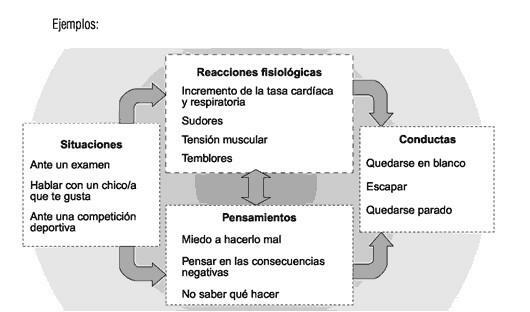
Emotions are natural reactions that allow us to alert ourselves to certain situations that involve danger, threat, frustration, etc. The central components of emotions are physiological reactions such as increased heart rate and respiration, muscle tension, and thoughts. It is necessary to acquire certain skills to manage emotions, since an excessive intensity can make people experience them as unpleasant states or lead them to perform behaviors undesirable.
Do you want to know what the best emotional control techniques are? In this Psychology-Online article, you will find 11 emotional control techniques They will help you handle any type of situation. These exercises are based on psychological studies and have been shown to be very effective.
Index
- What are emotional control techniques?
- Technique #1: Deep Breathing
- Technique #2: Thought Stopping
- Technique n° 3: Muscle relaxation
- Technique #4: Mental Rehearsal
- Technique #5: Thought Regulation
- Technique #6: Logical Reasoning
- Technique #7: Distraction
- Technique #8: Self-regulation
- Technique #9: Emotional Education
- Technique n° 10: Assertive Training
- Technique n° 11: Mindfulness and meditation
What are emotional control techniques?
When we talk about human emotions, these can be described by four specific aspects:
- A concrete situation.
- A series of specific physiological reactions or sensations such as quickening of the pulse and breathing, muscular tension, etc.
- Certain thoughts.
- A type of concrete responses appropriate to that situation.
Understand, know and admit emotions It is the procedure to be able to control them. For example, anxiety and anger are natural reactions that are activated in situations considered as dangerous, but they can also be activated by harmless stimuli, causing discomfort and behaviors inadequate. The result will depend on the emotional control you have.
If you want to learn strategies to improve your emotional control, the Master in Emotional Intelligence Online, designed by the Institute of Advanced Specialized Studies SERCA, addresses emotions at different levels, the intelligence in its different areas, emotional management, emotional improvement techniques, as well as its areas of application.
The educational program has been created so that students acquire the knowledge, skills, abilities and attitudes necessary to apply emotional enhancement techniques, as well as design intervention strategies from emotional intelligence and develop emotional education programs.
How to control emotions
Out of survival instinct, human beings look for specific ways to eliminate negative emotions. These solutions can be correct, such as playing sports, meditating, and breathing exercises, or inappropriate, such as smoking, drinking alcohol, and responding aggressively. Inappropriate behaviors can often have negative consequences.
Now that you know how emotions can negatively interfere in our lives if they are not managed, it is time to tell you the 11 emotional control techniques that will change the way you direct your feelings.

Technique n ° 1: Deep breathing.
One of the emotional control techniques that is very easy to apply and, in addition, is very useful for control physiological reactions before, during and after dealing with situations emotionally intense. It is done as follows:
- Take a deep breath while mentally counting to 4.
- Hold your breath while you mentally count to 4.
- Breathe out as you mentally count to 8.
- Repeat the above process.
Ultimately, it is about do the different phases of breathing slowly and a little more intense than normal, but without having to force it at any time. To check that you are breathing correctly, you can put one hand on your chest and the other on your abdomen. You will be doing the breathing correctly when only the hand of the abdomen moves when you breathe. Some also call it abdominal breathing.

Technique #2: Thought Stopping.
If we talk about techniques to control emotions, this can also be used before, during or after the situation that causes us problems. Specifically, it focuses on the thought control. To put it into practice you must follow the following steps:
- When you start to feel uncomfortable, nervous or upset, pay attention to the type of thoughts you are having, and identifies all those with negative connotations (focused on failure, hatred towards other people, blaming, etc.)
- Say to yourself “Enough!”
- Replace those thoughts with more positive ones.
The problem with this technique is that it takes some practice to identify negative thoughts, as well as to turn them around and turn them into positive ones.
Technique n° 3: Muscle relaxation.
This emotional self-regulation technique can also be applied before, during and after the situation, but for its effective use requires prior training. If you want to put it into practice, follow these steps:
- Sit quietly in a comfortable position. Close your eyes.
- Slowly relax all the muscles in your body, starting with your toes and then relaxing the rest of your body until you reach the muscles in your neck and head.
- Once you have relaxed all the muscles in your body, imagine yourself in a peaceful and relaxing place, for example, lying on a beach. Whichever place you choose, imagine yourself totally relaxed and carefree.
- Picture yourself in that place as clearly as possible.
Practice this exercise as often as possible., at least once a day for about 10 minutes each time. If you have been convinced of the usefulness of the exercise, remember that you must practice it in order to automate the process and relax in a few seconds.
Technique n° 4: Mental rehearsal.
Another of the emotional control techniques designed to be used before facing situations in which we do not feel safe. It consists simply of imagining that you are in that situation, for example, asking someone to go out with you, and that you are doing it well, while feeling totally relaxed and safe.
You should practice mentallywhat you are going to say and do. Repeat this several times, until you start to feel more relaxed and sure of yourself.

Technique n° 5: Regulation of thought.
When we are facing a moment of mental discomfort and we do not know how to manage our emotions, we usually experience something known as a "rush of thoughts". Many times, these uncontrolled thoughts are negative and do not allow us to find a solution to the stressful situation.
For the same reason, regulating thought can be an effective emotional control technique. How can we do it? The first step will be detect the stream of thoughts and identify what kind of ideas come to our heads. Next, we can try to write them down in a notebook if we are alone and then work on those affirmations.
Technique n ° 6: Logical reasoning.
Closely linked to the previous technique of emotional control, logical reasoning consists of analyze one by one the thoughts that cause us emotional discomfort and reason them logically. Here's an example of how to do it:
- Thought: "I'm useless and I'm useless"
- Emotion: sadness and crying
- Logic reasoning: "To what extent is that statement true? What good does it do me to think that of myself? What can I do to change that thinking?"

Technique #7: Distraction.
Techniques for managing emotions also include methods for moments of emergency, that is, when we cannot control feelings in any other way. When we feel overwhelmed by our emotions, we can try to distract ourselves with some comforting stimulus such as a song, a book, a movie, etc.
Technique n° 8: Self-regulation.
Emotional self-regulation is a technique to control the emotions that takes some practice, however it is very effective. To achieve self-regulation, we must follow the following steps:
- Detect and point out the moments in which we lose control.
- When we are calm, think about the triggers of the situation (what we were thinking when we lost control of our emotions).
- Identify trigger thoughts before they lead to uncontrollable emotions.
- Learn to regulate our emotions during times of crisis by helping ourselves with others relaxation techniques.

Technique #9: Emotional education.
This is one of the exercises to control emotions and prevent emotional crises. Emotional education consists of learn to detect feelings andvalue them without judging them negatively. All of our emotions are necessary on some level and help us adapt to the world around us.
Technique n° 10: Assertive Training.
Assertive training is one of the emotional control techniques that requires a specialist to be successfully completed. This group of psychological exercises aims to Learn to respond assertively in conflict. Some of the assertive training techniques are:
- Identify the situations in which we want to be more assertive.
- Describe problem situations.
- Write a script to change our behavior.
- Put this script into practice.
If you want to know more, you can take note of this article on social skills and assertiveness training.
Technique n° 11: Mindfulness and meditation.
Finally, to conclude this article on the best emotional control techniques, we are going to talk about mindfulness therapy. This emotional regulation technique is based on the principles of meditation and is highly effective in relaxing anxiety levels in times of emotional crisis.
Specifically, it is about stopping our torrent of thoughts and focus the mind on the "here and now", in our present sensations and in what surrounds us at that precise moment. Find out here how to apply mindfulness in cognitive therapy.
This article is merely informative, in Psychology-Online we do not have the power to make a diagnosis or recommend a treatment. We invite you to go to a psychologist to treat your particular case.
If you want to read more articles similar to Effective emotional control techniques, we recommend that you enter our category of Emotions.
Bibliography
- DE LAS HERAS RENERO, Mª DOLORES AND COLS. Discover program. Junta Castile and Leon.
- AND. HORSE, VINCENT. Manual of evaluation and treatment of social skills. XXI CENTURY. 1999.
- GOLDSTEIN ARNOLD. Social abilities and self-control in the adolescence. XXI CENTURY. 1999.
- LUENGO MARTÍN, Mª ÁNGELES AND COLS. Building Health. MEC.
- MARTHA DAVIS, MATTHEW MCKAY. Cognitive techniques for stress management. MARTINEZ ROCK. 1998.
- MARTHA DAVIS, MATTHEW MCKAY. Emotional self-control techniques. MARTINEZ
- VALLÉS ARANDIGA A. AND VALLES TORTOSA C. Social skills reinforcement program III. EOS.


